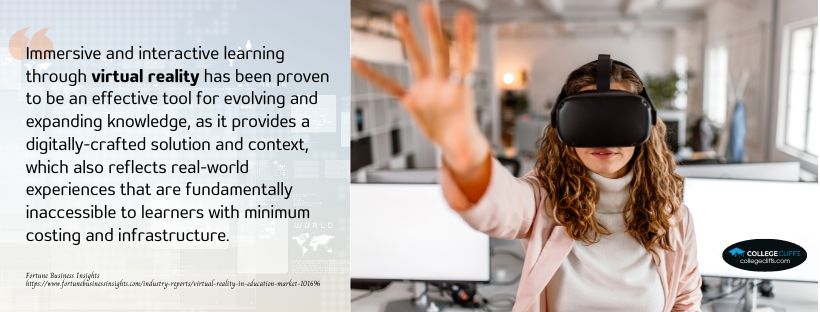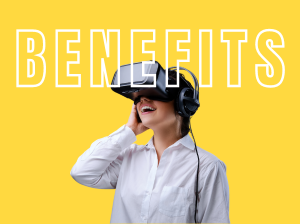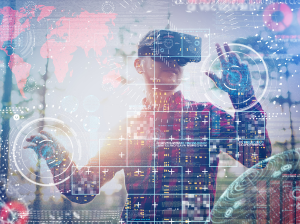How Are Colleges Using Virtual Reality (VR) for Education: What It Means for Students
Find your perfect college degree
The use of virtual reality in education, particularly among colleges and universities, is becoming more widespread, advanced, and advantageous!
In a Business Research Company study, the global virtual reality (VR) market with education applications has grown from $6.37 billion in 2021 to $8.66 billion in 2022 – and with a 39.7% compound annual growth rate, it’s projected to be $32.94 billion in 2026.
According to the Center for Digital Education, science, technology, and engineering are the three areas in higher education where VR is most commonly used.

What is Virtual Reality?
Jaron Lanier first coined “virtual reality” in 1987, and over the years, it has evolved under the auspices of the federal government, particularly by the NASA-National Aeronautics and Space Administration, the NSF-National Science Foundation, and the Department of Defense.
With federal government funding, university-based research laboratories have been and continue to be at the forefront of virtual reality.
Nowadays, virtual reality refers to the use of computer modeling and simulation technologies that create a simulated 3D environment where users can explore and interact with an artificial environment. Such is the lifelike design of the 3D environment that users become immersed in, whether it’s touring an ancient site or exploring the multifaceted design of modern buildings.
Known as telepresence, the illusion of actually being there usually results in users blocking out their physical surroundings.
Note that while computer hardware and software create the VR applications, users usually wear devices, such as a pair of goggles or a helmet with stereoscopic screen views and motion sensors, as well as joysticks. These aspects are also typical in the wide range of VR applications in education settings, from campus tours to simulated surgeries.
Benefits of Virtual Reality in Higher Education Settings

Both educators and students benefit from the use of virtual reality applications in their classrooms and laboratories! These benefits apply regardless of whether professors and students are in the same physical classroom or interact in a virtual classroom (i.e., online learning).
Indeed, the main beauty of VR applications in colleges and universities is their transcendence of the physical, geographical, and pedagogical distance that can separate the teachers and learners.
Boost Student Engagement and Immersion
The immersive experiences that VR applications provide for students immediately capture their attention and retain it for longer periods, resulting in more student engagement. The three-dimensional content stimulates multiple senses – sight, hearing, and even touch – that promote a deeper connection and understanding of the topic.
Students can then more easily visualize abstract concepts, understand complex topics, and even manipulate ideas according to their learning style.
Indeed, virtual reality is suitable for different types of learners, namely, the visual learners (i.e., visual aids), the auditory learners (i.e., listening), and the kinesthetic learners (i.e., hands-on experiences and physical activities). This isn’t just anecdotal, either!
In an Arizona State University study, students were divided into two groups – one learned via VR technology while the other learned via traditional in-person methods. The students in VR-enhanced classes demonstrated higher engagement and higher grades.
Provide Experience-based Learning
In STEM fields, such as medicine, nursing, and engineering, realistic simulations mimic real-world situations that enable students to gain hands-on experiences.
Students can practice their knowledge and apply their skills in a controlled environment, a combination that enables them to experiential learning while reducing their safety risks (i.e., real-world experimentation carries safety risks like infections and injuries).
The experience-based, hands-on learning experiences strengthen the students’ competence and confidence in the performance of real-world tasks.
The mind and muscle memory stays with them for far longer and deeper than with, say, reading from textbooks and listening to lectures. This is usually the case with medical simulations where students learn about anatomy and physiology via VR applications in lieu of cadavers.
Enable Customized Learning Environments
The use of VR technology in classrooms contributes to the creation of customized learning environments specifically designed for the students’ different learning needs and styles. Many VR systems use machine learning and artificial intelligence to adapt the learning experiences, such as changing the multisensory inputs based on the student’s preferences.
Simulations, 3D models, and interactive scenarios, as well as real-time feedback and assessments, are popular examples.
Enhance Distance Learning
Many online programs use VR technology to allow students to visit the campus, avail of counseling services, and gain hands-on learning experiences without their physical presence on site.
Virtual access removes physical and horological barriers, meaning students can access their learning materials presented in the form of virtual reality applications anytime, anywhere. Such convenience and flexibility enable students to study at their own pace, a particular benefit for working professionals and adult learners.
Collaborative learning experiences are also better with VR technology because students share a common virtual space that can be accessed regardless of their physical location. Students learn the hard (e.g., digital literacy) and soft skills (e.g., communication) that prepare them for multicultural workplaces and remote collaborations across geographical distances.
Enjoyment of Virtual Field Trips and Experiences
Students can also enjoy virtual trips and their related experiences without being in the location. This is beneficial to remote locations or challenging sites (e.g., conflict areas) that students cannot easily access in person. Students can explore ancient archaeological sites, visit outer spaces, and even travel through the human body.
The dynamic, engaging, and interactive aspects of VR technology encourage students to learn more about the subject matter, even to learn without the stress of putting themselves and others at risk (i.e., a safe space). With more confidence in their competencies, students are more motivated, too.
Virtual Reality Applications in College Education

With more and more colleges adapting VR technology in their classrooms and services, the innovative uses keep on coming! The wide range of uses starts from student recruitment to instruction and training, counseling services, and professional development.
Student Recruitment
Even among selective colleges and universities, student recruitment can be a challenge (i.e., the acceptance rate is usually higher than the yield rate).
Prospective students and their parents consider campus tours as an essential aspect of their decision-making process, but it can be cost- and time-consuming, particularly with campuses outside of their local communities. The solution: Virtual campus tours that allow prospective students and their parents to explore the many parts of the campus, including its facilities, amenities, and services, in the comfort of their own homes.
Harvard University, Columbia University, and Princeton University are among the top-tier universities with excellent virtual campus tours using VR technology.
Medical Training
Medical students traditionally use textbooks and cadavers for their medical training on the physiology and anatomy of the human body.
However, VR technology makes it possible for medical students to practice their knowledge and refine their skills about the human body in a risk-free, controlled environment. This is of particular importance considering the shortage of cadavers among many colleges and universities that, in turn, can result in medical schools without cadavers.
The realistic surgical simulations that VR technology can provide also allow medical students and aspiring surgeons to hone their surgical skills before operating on a live human, a risk-free training option.
The best VR technology used in medical schools even provides a wide range of possible scenarios, such as hemorrhages or cardiac arrest, that enable users to react appropriately.
Science Simulations and Virtual Laboratories
Even among well-funded colleges and universities, state-of-the-art laboratories and related research facilities where hands-on STEM learning takes place aren’t easy to build and maintain. With VR technology, however, college students can perform scientific experiments and simulations from their personal computers!
Indeed, virtual laboratories allow students to conduct ultrasound exams, track cellular respiration, and culture bacteria on their computers – and these are also risk-free settings that build the students’ competence and confidence in their abilities.
VR technology is also used in creating immersive and interactive simulations in the fields of physics, astronomy and engineering. College students can explore outer space and its celestial objects, observe the laws of physics in a realistic environment, and explore complex designs in architecture and engineering.
Historical and Cultural Reconstructions
While time travel hasn’t been invented yet, the use of VR technology overcomes the barriers of time and space in the study of history, including the peoples, places, and periods of the past. Students can be transported to a wide range of places, periods and events, such as ancient sites, cultural settings, and historical events.
With historical and cultural reconstructions in the physical sense being more expensive, the use of VR technology makes them more affordable and accessible to students. This is particularly true considering that it’s easier and faster to make changes to virtual landscapes and events than with physical reconstructions.
Students also develop a deeper sense of cultural awareness and appreciation for diverse cultures, thanks to virtual tours of historical sites or museums that provide interactive cultural experiences.
Language Learning
The use of VR technology in language learning is among the most popular applications because it’s more affordable to learn a language in the comfort of your home and more conducive to learning with realistic scenarios.
Students learning a foreign language can use VR applications to order food, talk with the locals, and navigate foreign places while speaking the local language – all without spending on expensive plane fare and accommodations.
Virtual Field Trips
As previously mentioned, VR technology makes it possible for college students to enjoy field trips and experiences that can be challenging in terms of costs and logistics. Their educational experiences broaden their horizons without spending a dollar.
Such an application of VR technology is of particular importance among students studying history, archaeology and environmental sciences, among other fields that usually require on-site visits.
Soft Skills Development
College students must not only develop the technical skills in their field but also develop their transferable skills applicable to any field. This can be made possible through VR technology, such as in simulated professional environments where students practice their communication, collaboration, and problem-solving skills in realistic yet controlling settings.
Indeed, VR technology is used in professional development services, too, such as in mock job interviews and presentations.
The versatility of VR technology applications in colleges and universities means that it will be around for a long time to come!
Successful Implementations of VR Technology

With many colleges and universities offering virtual reality as an academic discipline – Massachusetts Institute of Technology, Stanford University, and Georgia Institute of Technology are a few of the best – it’s no surprise that VR technology is prevalent in higher education.
Here are a few examples of colleges and universities with successful implementations of VR technology in education.
University of Arkansas Uses VR in Marketing
The University of Arkansas Pulaski Technical College is considered among the pioneers and innovators in their use of VR technology for marketing purposes. The college has even won awards for its VR library tours, as well as being known for its immersive virtual campus tours and its virtual experiences showcasing its culinary school.
Texas State University Made the VR Ambulance Bus Tour Experiences
In partnership with the State of Texas, Texas State University created the Ambulance Bus Tour experiences using VR technology.
The VR application educates aspiring ambulance drivers and technicians about the inner workings of Ambulance Buses, which can only be used during mass casualty events and other extraordinary circumstances.
Emporia State University Leverages Virtual Reality
Instructors at Emporia State University create engagingly interactive and immersive VR applications that boost student engagement and learning. The use of VR technology, particularly 360 apps, covers diverse disciplines, too, including business marketing, forensic science, and history.
San Diego State University Uses VITaL
In 2017, San Diego State University allowed its educators to borrow VR gear that allows their students to experience new learning environments that make complex subjects more understandable.
In astronomy classes, for example, students gain a better understanding of complex subjects when they can visualize them instead of just listening to the lectures. Educators can also use the Virtual Immersive Teaching and Learning (VITaL) Learning Research Studio for this purpose.
University of Central Florida Uses VR in Its Counseling Services
With student mental health in crisis, colleges and universities must find innovative ways of addressing the mental health and wellness needs of students, even their faculty and staff members.
The University of Central Florida, through its Restores program, uses immersive VR technology to provide counseling services through exposure therapy (i.e., processing traumatic memory through sights, sounds, and smells).
Roberts Wesleyan University also uses VR technology in its on-campus clinic for students, faculty and staff members, and others dealing with anxiety-related issues.
Johns Hopkins Uses VR for Medical Training
The Johns Hopkins School of Nursing utilizes VR technology to train its nursing students at all levels, from prelicensure to doctoral degree programs. Nursing students train in a wide range of areas, including pediatric critical care, acute care management, post-surgical management, anaphylactic reactions, and resuscitation.
The VR system includes an Alienware computer and an Oculus headset, as well as hand haptics with software designed by Oxford Medical Simulation.
The University of Central Florida College of Nursing also uses VR and AR technology in nurse training, such as in seeing inside the body.
Massachusetts General Hospital’s VR-enhanced Orthopedic Surgical Training
Massachusetts General Hospital uses PrecisionOS to boost the quality of its orthopedic surgical training for its residents and medical students, particularly in motor skills vital for success in surgical operations.
Soft Skills Development Through VR and AR Technology

Meta, formerly known as Facebook, Inc., collaborated with 15 colleges and universities in the United States in the use of VR and AR technology in their classrooms and in the study of the ways in which these immersive technologies can contribute to education.
The social media giant wants college students to learn through VR technology, particularly by teaching soft skills.
Examples include:
- Stanford University using the BodySwaps app for soft skills development among business students
- The University of Iowa uses VR technology in the same way as Stanford for its business students’ soft skills development.
Of course, it isn’t just in soft skills development that colleges and universities have found ways of maximizing VR technology! Miami Dade College, for example, offers VR-enhanced courses across diverse disciplines, including chemistry, biology, and music. Morehouse College also has its metaverse with VR-enhanced classes in journalism, business, biology, and chemistry – and its proof-of-concept pilot resulted in a 10% increase in GPAs, too.
Of course, some challenges come with using VR technology in colleges and universities, such as the cost of the equipment and their upkeep, the integration of VR apps into the teaching pedagogy and existing curriculum, and the issues related to equal and inclusive access, as well as data privacy and security.
But as technology evolves, these issues can be addressed, and the benefits of VR technology as a teaching tool become even more widespread. We believe that VR technology will provide educators and students with even more immersive learning experiences, more collaborative learning spaces, and more accessibility and inclusivity.
We also project that colleges and universities will use VR technology to develop quality content that best serves the interests of students.
Additional Resources:
